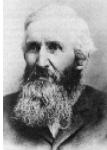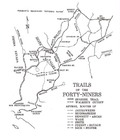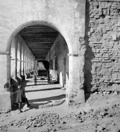 William L. Manly (1820-1903)They had been given fifteen days to find help—or something to eat, or at the very least a decent trail—and then return to camp. They set off, their packs filled with with "seven-eighths of all the flesh of an ox... a couple spoonfuls of rice and about as much tea... [and] all the money there was in camp."
William L. Manly (1820-1903)They had been given fifteen days to find help—or something to eat, or at the very least a decent trail—and then return to camp. They set off, their packs filled with with "seven-eighths of all the flesh of an ox... a couple spoonfuls of rice and about as much tea... [and] all the money there was in camp.""They crossed a gap south of Telescope Peak, staying on the mountain that night," wrote historian W.A. Chalfant in Death Valley: The Facts (1930). "They descended to the pool in the Panamint Valley, only to find its brine a literally bitter disappointment. On the next range they found the Jayhawker trail, and near it holes dug by that party in the vain hope of finding water. Near the summit they came upon the body of Fish ["a Mr. Fish of Indiana"], lying as he had fallen."
They descended the west flank of the Argus Range, across what is now the China Lake Naval Air Weapons Station, and from the Cosos, by the light of the moon, made a beeline for the snow in the Sierra Nevada.
"At the end of the second night Rogers went up a little canyon, hunting for water," wrote Chalfant, "and at sunrise chanced upon a little ice, with which they filled a kettle."

Trails of the Forty-Niners, from Lingenfelter's Death Valley & the Amargosa: Land of Illusion"I can but think how providential it was that we started in the night," wrote Manly himself, years later, "for in an hour after the sun had risen, that little sheet of ice would have melted and the water sunk into the sand." (For a handsome and expertly annotated version of Manly's account, try Leroy and Jean Johnson's Death Valley in '49 (Heyday Books, 2001).)
They headed south, along a trail that is now US 395, away from the Owens Valley. They overtook what was left of the Jayhawker party at Indian Wells, now home to a mediocre steakhouse and a fine microbrewery.
They crossed the Mojave, generally following the route of present-day CA 14, past the gateway to Walker Pass, down Red Rock Canyon and across what is now Palmdale and Lancaster. Along the way they found the bones of numerous dead horses and oxen, and saw their first Joshua Trees (which they called "cabbage trees": "It was a brave little tree to live in such a barren country.")
In Soledad Canyon they were surprised by a crow lighting on a nearby shrub. "And we surprised him," wrote Manly, "by killing him with a charge of shot."
That night, camped on the banks of a "beautiful little running brook of clear, pure water," they ate roasted quail and a stew of crow and hawk, and thought themselves "on the edge of the promised land."
The following day they sighted a pair of horses in the distance, and later "a pack of prairie wolves." Leaving the Santa Clara by way of an old Indian short-cut (in the direction of present-day Saugus), they reached the summit of a spur of hills, and found "a most pleasing sight."
"There before us," wrote Manly, "was a beautiful meadow of a thousand acres, green as a thick carpet of grass could make it, and shaded with oaks, wide-branching and symmetrical, equal to those of an old English Park, while all over the low mountains that bordered it on the south and over the broad acres of luxuriant grass was a herd of cattle numbering many hundreds, if not thousands... tears of joy ran down our faces. If it was, as I believe, the beginning of the year (1850), it was certainly a most auspicious one and one of the most hopeful of my life."
It was in fact, by LeRoy and Jean Johnson's calculations, the 25th of January—ten days after setting out from the Bennet-Arcane camp in Death Valley.

Mission San Fernando Rey de España, circa 1900, where Rogers and Manly were finally able to procure supplies for the long march back to Death ValleyThey killed a steer, "had it roasted and eaten almost quicker than can be told," made new moccasins from its hide, and continued on their way. At some point Rogers traded his patent leather belt for a "quart or more of cornmeal."
Here (source of some of my confusion) Chalfant wrote: "They reached the home of a Mexican family, were treated with the utmost kindness, and partly equipped for the return journey. At another camp they obtained more help, and when on the back track they reached Elizabeth lake with three horses, a mule, a sack of beans, a small sack of wheat, some good dried meat, and some coarse flour."
In fact, five days later, still heading south on the road to Los Angeles, having just passed the Mission San Fernando Rey de España—today found at the center of a triangle formed by the junctions of three major freeways (I-5, I-405, and CA 118), some 250 miles from where their erstwhile companions were still huddled beneath wagons—they met Mr. Darwin French, then of the Tejon Ranch, later to become founder of the town of Darwin, between Owens Lake and Death Valley. Mr. French offered to help them procure supplies for the long march back.
They turned around with Mr. French, rode back to the Mission where the Spaniards gave Rogers and Manly a floor to sleep on in the storehouse, a floor which Manly described as "not soft." "This was the second house we had slept in since leaving Wisconsin," he wrote, "and it seemed rather pent up to us."
The following day, in exchange for thirty dollars cash, the unlucky Americans were furnished with yellow beans, wheat, dried meat, some coarse flour, two packhorses, saddles and ropes. Along the trail they also managed to pick up "a poor little one-eyed mule" and for Manly's last fifteen dollars "a little snow white mare as fat as butter."

Recent tailings from Briggs Mine, Panamint Basin. desertwilderness.netAt the foot of the Panamints, above what is now the very quiet town of Ballarat, where only the mule could handle the terrain, they were forced to abandon the horses. "One who has never heard the last, despairing, pleading neigh of a horse left to die can form no idea of its almost human appeal," wrote Manly.
They climbed Redlands Canyon, up a trail that skirted what later came to be known as Manly Falls, a trail and landscape recently made memory by the excavation of an open-pit gold mine. "Manly Fall at the mouth of the canyon is no longer there," wrote LeRoy Johnson, recent editor of Manly's Death Valley in '49, in response to a question posted to the DV Talk Forum. "It is still not permissible to hike up Redlands Canyon (because of the Briggs Mine) but you can jeep down from the top some distance and hike to the exit of the canyon; then, you have to hike back up."
"Can one imagine the joy in that despairing camp when Rogers and Manly reappeared?" wrote Chalfant. The scene, such as Manly and others reconstructed it, is one of the most moving in American history:
"Bennett and Arcane caught us in their arms and embraced us with all their strength, and Mrs. Bennett, when she came, fell down on her knees and clung to me like a maniac in the great emotion that came to her, and not a word was spoken. If they had been strong enough, they would have carried us to camp upon their shoulders. As it was, they stopped two or three times and turned as if to speak, but there was too much feeling for words; convulsive weeping would choke the voice."
All that remained was to abandon the wagons, and all but the most essential gear, to lash the children to the backs of the starving oxen, and to head out once again across 250 miles of some of the roughest desert terrain in the world...